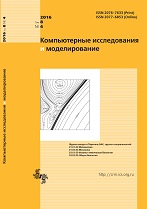|
COMPUTER SCIENCE IN SPORT
Numerical simulation of sportsman's external flow
V. V. Zharkova, A. E. Shchelyaev, J. V. Fisher
Ltd. «TESIS»,
18 Yunnatov st., Moscow, 127083, Russia
Abstract:
Numerical simulation of moving sportsman external flow is presented. The unique method is developed for obtaining integral aerodynamic characteristics, which were the function of the flow regime (i.e. angle of attack, flow speed) and body position. Individual anthropometric characteristics and moving boundaries of sportsman (or sports equipment) during the race are taken into consideration. Numerical simulation is realized using FlowVision CFD. The software is based on the finite volume method, high-performance numerical methods and reliable mathematical models of physical processes. A Cartesian computational grid is used by FlowVision, the grid generation is a completely automated process. Local grid adaptation is used for solving high-pressure gradient and object complex shape. Flow simulation process performed by solutions systems of equations describing movement of fluid and/or gas in the computational domain, including: mass, moment and energy conservation equations; state equations; turbulence model equations. FlowVision permits flow simulation near moving bodies by means of computational domain transformation according to the athlete shape changes in the motion. Ski jumper aerodynamic characteristics are studied during all phases: take-off performance in motion, in-run and flight. Projected investigation defined simulation method, which includes: inverted statement of sportsman external flow development (velocity of the motion is equal to air flow velocity, object is immobile); changes boundary of the body technology defining; multiple calculations with the national team member data projecting. The research results are identification of the main factors affected to jumping performance: aerodynamic forces, rotating moments etc. Developed method was tested with active sportsmen. Ski jumpers used this method during preparations for Sochi Olympic Games 2014. A comparison of the predicted characteristics and experimental data shows a good agreement. Method versatility is underlined by performing swimmer and skater flow simulation. Designed technology is applicable for sorts of natural and technical objects.
Keywords:
FlowVision, computational fluid dynamics, aerodynamics, numerical simulation, CFD, speed skating, ski jumping, swimming.
Received: 06.12.2016
Revised: 16.01.2017
Accepted: 03.03.2017
Citation:
V. V. Zharkova, A. E. Shchelyaev, J. V. Fisher, “Numerical simulation of sportsman's external flow”, Computer Research and Modeling, 9:2 (2017), 331–344
Linking options:
https://www.mathnet.ru/eng/crm67 https://www.mathnet.ru/eng/crm/v9/i2/p331
|

| Statistics & downloads: |
| Abstract page: | 241 | | Full-text PDF : | 101 | | References: | 36 |
|




 Contact us:
Contact us: Terms of Use
Terms of Use
 Registration to the website
Registration to the website Logotypes
Logotypes








 Citation in format
Citation in format 